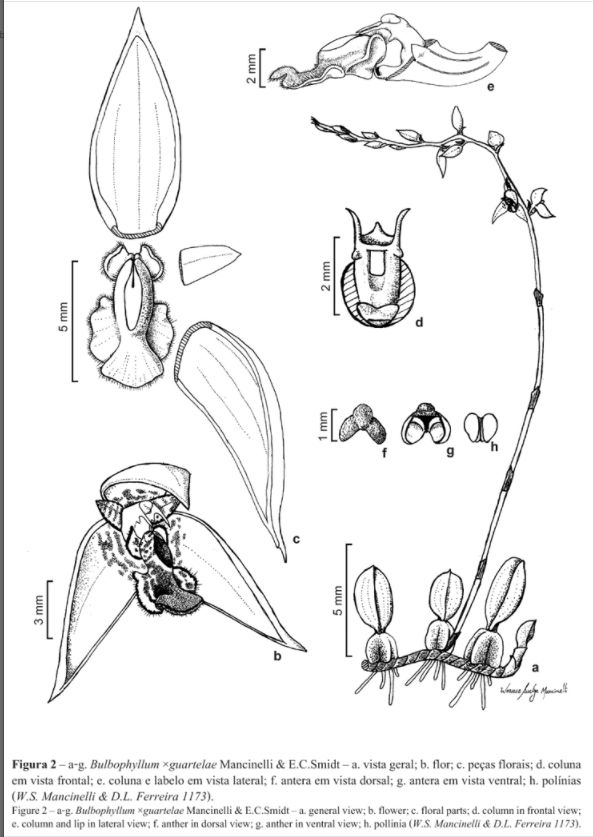

Bulbophyllum × guartelae Mancinelli & E.C.Smidt 2012 SECTION Didactyle [Lindley] Cogn. 1902 TYPE Drawing by © Mancinelli & E.C.Smidt and Rodriguésia 63 (4) • Dec Mancinelli and Ferriera 2012



Common Name The Guartela Canyon Bulbophyllum
Flower Size .52" [1.2 cm]
Found in Parana state of Brazil at elevations around 700 to 900 meters as a mini-miniature sized, warm growing natural hybrid between B. tripetalum Lindley and B. peri with a creeping rhizome giving rise to distinct, ovoid, longitudinally sulacate pseudobulbs carrying a single, apical, erect. oblong, mucronate, shortly petiolate base leaf that blooms in the fall on an erect, peduncle 8.8" [22 cm] long, rachis 5.56" [13.9 cm] long, to 15 flowered inflorescence.
The new hybrid species is known from only one individual found in the municipality of Tibagi (PR), where sympatric populations of B. peri and B. tripetalum are located, with overlapping flowering periods. The characteristics of this hybrid are intermediate between B. peri and B. tripetalum, regarding the distance between flowers in the inflorescence, size, shape and color of the floral parts. It can be recognized by the flat orbicular median lobe with only the apical region showing a crease. In the SECTION Didactyle [Lindley] Cogn. 1902, the species present a supply of nectar (Teixeira et al. 2004), and the mobility of the lip with the aid of the wind is an essential factor for pollination (Borba & Semir 1998b). In this section, self-compatibility and seed viability were verified in interspecific crosses (Borba et al. 1999), with the gradual reduction in pollinia size – probably via dehydration – a barrier to self-pollination and interspecific pollination (Borba & Semir 1999). Bulbophyllum ×cipoense Borba & Semir, the only hybrid described so far and also belonging to this section, presents self-incompatibility or sterility as a post-pollination isolation mechanism (Borba & Semir 1998a). In B. peri and B. tripetalum, the pollinators or resources for attracting them are unknown. In both, the mobility of the lip occurs due to the wind, but there is a noticeable difference in the size, shape and color of the floral parts (especially the lip), column, stigmatic cavity and pollinia. Due to the fact that only one individual with such intermediate features was found, its fertility or attractiveness to pollinators could not be evaluated, requiring further studies on the reproductive biology of the parents and the hybrid in question." Mancinelli and Camargo Smidt 2012
Synonyms
References W3 Tropicos, Kew Monocot list , IPNI ; * Rodriguésia 63 (4) • Dec Mancinelli and Camargo Smidt 2012 drawing fide;
----------------------------------------------------------------------------------------------------------